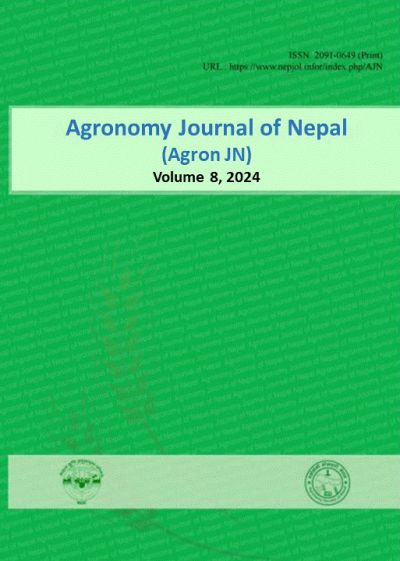Superior Buckwheat Genotypes for the River-Basin Areas of Sudurpaschim Province
DOI:
https://doi.org/10.3126/ajn.v8i1.70893Keywords:
Buckwheat, climate change resilience, mountainous environments, mid-hills, glutenAbstract
Buckwheat is considered one of the climates smart crops, and it can play a significant role in food security in Nepal's hills and mountainous regions. Field experiments were conducted to identify suitable buckwheat genotypes for general cultivation in the mid-hills of far-western Nepal. The experiment was laid out in a randomized complete block design with three replications in both years. The experiments were conducted in the research field of the Directorate of Agricultural Research, Sudurpaschim Province, Bhagetada, Doti, during the two consecutive winters of 2019 and 2020. Eleven elite buckwheat genotypes received from the Hill Crops Research Program, Kabre, Dolakha, Nepal, were evaluated. The only released variety of sweet-type buckwheat, Mithe Fapar-1, was used as a standard check. There was a significant difference among the genotypes in both years. In 2019, genotypes Acc#5670 (1390 kg ha-1), standard check - Mithe Fapar-1 (1250 kg ha-1), PL-30 (1240 kg ha-1), KLF-72-22-520 (1199 kg ha-1), and Acc#6529 (1190 kg ha-1) were identified as higher yielder. In 2020, Acc#5670 (1556 kg ha-1), GF-5283 (1,434 kg ha-1), Acc#2234 (1,399 kg ha-1), Acc#2213 (1361 kg ha-1), and Acc#6529 (1312 kg ha-1) were found superior among the tested genotypes. Likewise, combined over 2019 and 2020 data revealed that the genotypes Acc#5670 (1473 kg ha-1), Acc#2234 (1275 kg ha-1), Acc#2213 (1261 kg ha-1), Acc#6529 (1251 kg ha-1), and the genotype GF-5283 (1247 kg ha-1) were found, high yielder. Genotypes found superior in these field experiments are valuable resources for the buckwheat breeding program of Nepal (Hill Crops Research Program) and especially for the mid-hills of Sudurpaschim Province. The superior genotypes can further be evaluated to develop location-specific genotypes for the regions.
Downloads
Downloads
Published
How to Cite
Issue
Section
License
Copyright (c) 2024 Agronomy Society of Nepal (ASoN)

This work is licensed under a Creative Commons Attribution-NonCommercial 4.0 International License.
ASON permits for free use, distribution and reproduction in any medium if the original work is properly cited and not used for commercial purposes.




